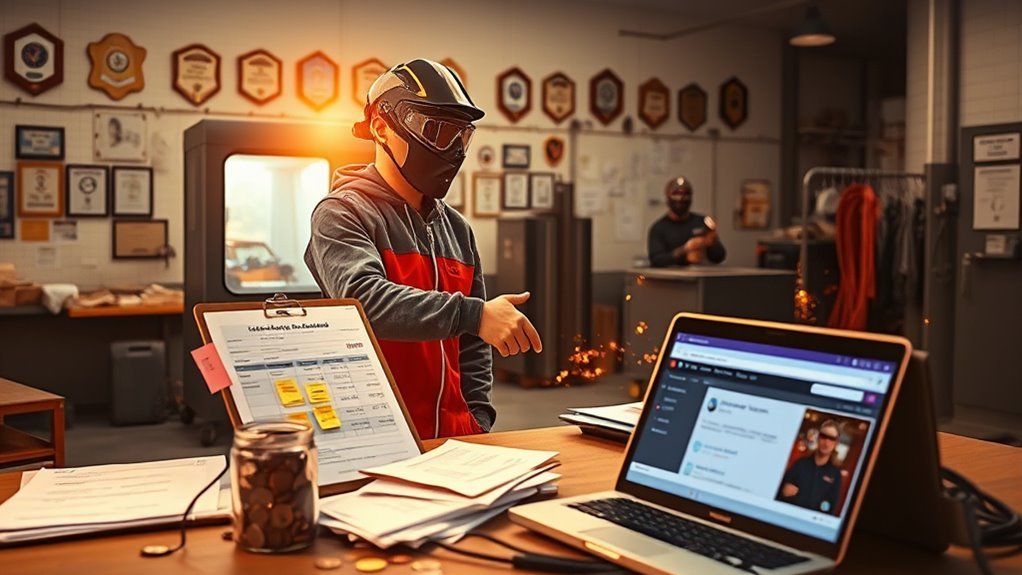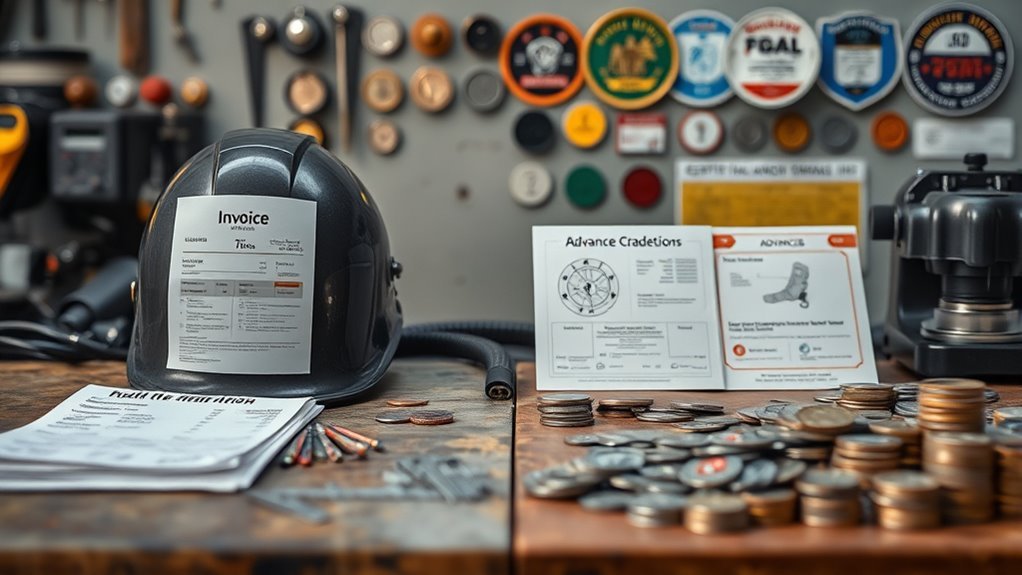About 70% of U.S. welding jobs now require a certified qualification, so you’ll want a clear budget before you start. You’ll face exam fees, PPE and tool purchases, and training costs that vary widely by program and specialty. Safety standards and credentialing rules will shape what you need and how long it takes, and understanding those differences will save you time and money—here’s what to evaluate next.
Typical Fees for Welding License Exams

Expect to pay roughly $120 in Los Angeles for the combined practical and written welding license exam, though total costs will often be higher once you add required code manuals, specialty endorsements, and possible re-test or application fees.
You should treat that $120 as the baseline in your exam fee breakdown and plan for predictable add-ons. Buy the latest AWS structural welding code manuals for the open‑book portion — they’re essential, not optional, and add to welding certification costs.
If you pursue specialized fields like Sheet Metal or Chemical Plant work, expect supplemental license fees and endorsements. Some jurisdictions tack on application or administration fees ranging roughly $50–$300, so confirm the licensing authority’s schedule before you schedule testing.
Also budget for re‑examination fees if you don’t pass on the first try. By itemizing each line — exam, manuals, endorsements, application, retest — you’ll manage costs and maintain a safety‑focused approach to certification.
Training and Course Costs by Program Type

When you’re budgeting for training, expect certificate programs to be the most affordable option, typically running $3,000–$10,000 and finishing in weeks to months.
Associate degrees are more costly — often $10,000–$25,000 for roughly two years and about 60 units — while trade and diploma schools fall in between at $5,000–$15,000.
Don’t forget tools and PPE, which can add $100–$2,000 to your total, so plan for safety expenses up front.
Certificate Program Costs
While program costs vary by institution and length, you’ll typically pay between $3,000 and $10,000 for a welding certificate program, with community college two‑year diplomas often near $5,000 and trade schools ranging from $5,000 to over $20,000 for specialized training.
When comparing welding program comparisons, focus on hands‑on hours, instructor credentials, and clear certification benefits like employability and testing prep.
Expect added expenses: safety gear and consumables ($100–$500) and a personal welding machine if required ($500–$2,000).
Some certificate units carry per‑unit tuition differentials — for example, $368 for in‑state versus $2,672 for out‑of‑state on an 8.0 unit course.
Choose programs that prioritize safety training and measurable skill assessments.
Associate Degree Expenses
Many associate degrees in welding require 60 units, costing roughly $2,760 for in‑state students and about $20,040 for out‑of‑state students, not including books, consumables, or safety gear.
If you pursue an associate degree, you’ll get broader shop time, safety training, and classroom theory that help on certification exams and jobsite safety.
Do a tuition comparison: associate costs can be lower per credit than specialized short programs but usually take longer.
Factor in in state benefits like reduced rates, access to state grants, and lower fees when budgeting.
Expect additional costs for PPE and consumables ($100–$500).
Choose a program that balances cost, safety instruction, and hands‑on hours to meet licensing and employer standards.
Trade School Pricing
Trade school welding programs typically cost between $5,000 and $20,000, so you should budget based on program length and credential type. You’ll find certificate courses (weeks–months) from $3,000–$10,000, diplomas around $5,000–$15,000 for one year, and associate degrees nearer $10,000–$25,000 for two years. Factor in $100–$500 for PPE and consumables and $500–$2,000 if you buy a beginner welder. Financial aid, scholarships, and grants reduce out‑of‑pocket costs, and trade school benefits include focused skills training that improves your welding job outlook.
| Program type | Typical cost |
|---|---|
| Certificate | $3,000–$10,000 |
| Diploma | $5,000–$15,000 |
| Associate | $10,000–$25,000 |
| Extras (gear/equipment) | $100–$2,000 |
Required Personal Protective Equipment and Tools

One essential step before you start welding is assembling the right personal protective equipment and basic tools to keep yourself safe and productive.
For welding safety you’ll need a quality welding helmet with proper shade (expect $100–$300) to shield your eyes from arc flash, plus heat‑resistant welding gloves ($20–$100) to protect your hands.
Add a welding jacket or sleeves ($50–$200) to guard your torso and arms from sparks and spatter, and steel‑toed safety boots ($50–$200) to protect your feet from falling objects and hot materials.
These items are core protective gear you should own before practical training or testing.
Beyond PPE, basic tools and a welding machine dramatically affect total cost: entry‑level units start around $500, while more capable machines run up to $2,000.
Choose certified, well‑rated equipment to meet course or licensing requirements, and prioritize durability and fit — proper PPE and reliable tools reduce injury risk and improve your technique during practice and exams.
State and Local Application or Processing Fees

When you apply for a welding license you’ll face application filing fees that vary by state, often between $50 and $200.
In places like Los Angeles expect about $120 to cover both practical and written exams, with extra local examination charges or city/county licensing fees possible.
Verify with the local regulatory office so you’re budgeting for any additional processing or renewal costs.
Application Filing Fees
Application filing fees vary by state and locality, and you’ll usually pay a processing fee to submit a welding license application plus separate exam charges—expect roughly $120 for practical and written tests in Los Angeles.
You should confirm application deadlines, available fee waivers, and exactly which local agency handles submissions. Processing fees cover administrative review; some jurisdictions add inspection or certification verification charges.
Factor training and certification costs too, since they can dwarf filing fees. Check the agency’s fee schedule before you apply so you won’t be surprised.
- Frustration when unexpected fees delay your certification.
- Relief when you qualify for fee waivers or spot a waiver option.
- Confidence after confirming deadlines and total costs.
Local Examination Charges
Now that you’ve confirmed filing fees and deadlines, look closely at local examination charges because they often make up a large portion of your out‑of‑pocket cost.
In Los Angeles expect about $120 for the combined practical and written exams; additional state and local application or processing fees may raise that total. Some jurisdictions add a separate issuance fee once you pass.
Factor in study material costs — current AWS structural welding code manuals are often required for open‑book written tests.
Verify local examination requirements with the licensing authority before you schedule exams. Adopt testing preparation strategies that prioritize hands‑on practice and code familiarity to reduce retest risk.
Confirm updated fees and document lists to avoid surprise expenses and maintain safety compliance.
Additional Costs: Materials, Books, and Lab Fees

Although tuition covers instruction, you’ll still pay for essential materials, safety gear, books and lab fees that can add several hundred dollars to your total cost.
Plan for welding materials expenses and safety gear costs in your budget: PPE like helmets, gloves, sleeves and basic consumables typically run $100–$500.
Books and course supplies add another $100–$500, and lab fees vary by school, often several hundred dollars more.
You should treat these as mandatory safety and training investments, not optional extras.
- Imagine starting a shift without certified PPE — the risk isn’t worth the savings.
- Picture the relief when your textbook explains a technique before you weld live.
- Feel confident knowing lab fees keep equipment maintained and safe.
Budget conservatively, shop for certified PPE, and confirm lab fee policies with your program coordinator so you won’t face surprise costs during certification.
Financial Aid, Scholarships, and Apprenticeship Options

Want to reduce out‑of‑pocket costs for welding certification? Use targeted financial aid strategies: complete the FAFSA to access federal loans and grants that can cover tuition and materials, and meet with a school’s financial counselor to map aid against program costs.
Seek scholarship opportunities from trade associations, unions, and private companies — these awards often target welding students and cut your expenses considerably.
Consider apprenticeship programs for hands‑on training that pay a stipend or wage; apprenticeships let you earn while you learn and may cover some training fees, lowering total cost and reinforcing safety skills on the job.
Consider apprenticeships — earn a wage while you learn, reduce training costs, and build hands-on welding and safety skills.
Combine scholarships, grants, and apprenticeship income first, then use loans for remaining balances to minimize debt. Keep documentation current and meet deadlines to preserve eligibility.
Prioritize programs that include financial counseling and transparent cost breakdowns so you can plan safely and avoid unexpected charges during certification.
Cost Differences for Specialty and Advanced Certifications

After you’ve explored scholarships and apprenticeships to lower basic training costs, you should expect specialty and advanced certifications to raise your budget considerably.
You’ll see wide ranges: specialty certification costs such as Certified Welding Inspector often run $1,000–$3,000 including materials, while advanced certification prerequisites and coursework for Certified Welding Engineer push total costs to $2,000–$5,000.
AWS exam fees vary — basic tests can start near $300; advanced exams may exceed $1,000. Practical exam fees (about $120) and travel can add up. Some credentials require documented experience or extra classes, so factor those prerequisites into your plan.
- You’ll feel challenged when facing higher fees and strict prerequisites.
- You’ll appreciate the safety and credibility that justify the expense.
- You’ll need discipline to meet experience requirements and pass rigorous exams.
Budgeting precisely keeps you safe, compliant, and competitive in the field.
Calculating Total Investment and Return on Training

When you add exam fees, gear, training and travel, a realistic total cost for becoming a licensed welder in California usually falls between about $5,500 and $20,000, depending on program level and equipment choices.
You should break costs into exam fees (~$120), safety gear ($100–$500), machines ($500–$2,000), and tuition ($5,000–$15,000). Include travel and consumables for accurate budgeting.
Do an investment analysis that factors in financial aid, scholarships, and lower-cost community college options to reduce upfront outlay. Compare net present cost to projected income streams.
Include financial aid, scholarships, and lower‑cost community college paths; compare net present cost to expected income streams.
Focus on safety-driven expenditures — quality PPE and reliable equipment reduce long‑term risk and replacement costs.
Use conservative assumptions for job placement and downtime when modeling returns. With median annual wages around $51,000 (2023), potential earnings usually justify training within a few years.
Track certifications and skill upgrades; each additional credential often increases earning power and accelerates return on training.
Frequently Asked Questions
Can Prior Military Welding Experience Reduce Licensing Costs?
Yes — your prior military welding experience can reduce licensing costs. You’ll leverage military welding benefits and experience recognition to skip training, get exam waivers or reduced fees, but you’ll still meet civilian safety standards and documentation requirements.
Do Online Welding Certificates Count Toward State Licenses?
Generally, online certification recognition varies: you’ll need to meet state licensing requirements and often complete hands‑on testing. Don’t assume online-only certificates suffice; confirm state rules, submit proof, and pass practical weld exams for safety compliance.
Are Background Checks or Drug Tests Required for Licensing?
Yes — many states require background check requirements and drug test policies for welding licenses; you’ll undergo criminal history screening and often pre‑employment or random drug testing to guarantee safety, compliance, and trustworthiness in welding roles.
Can Employers Cover Licensing and Exam Fees for New Hires?
Yes — employers can cover fees: like a steady anvil, they offer employer reimbursement and licensing support, so you’ll get paid tuition, exam costs, and guided prep, ensuring qualified, safe welders enter the shop.
How Long Is a Welding License or Certification Valid?
Welding certification duration varies by issuer but typically lasts 1–3 years; you’ll follow the license renewal process requiring recertification exams, documented experience, or refresher training to maintain qualification and guarantee safe, compliant work.
Conclusion
Think of getting your welding license like forging a blade: it takes heat, time, and careful investment. You’ll face exam fees, PPE and tool purchases, tuition or apprenticeship costs, plus materials and possible retests. Plan for roughly $5,500–$20,000 in California depending on program and specialties. Stay safety‑first, choose accredited training, and track all expenses—doing so sharpens your skills and protects your return on investment as you build a reliable, long‑lasting trade.


